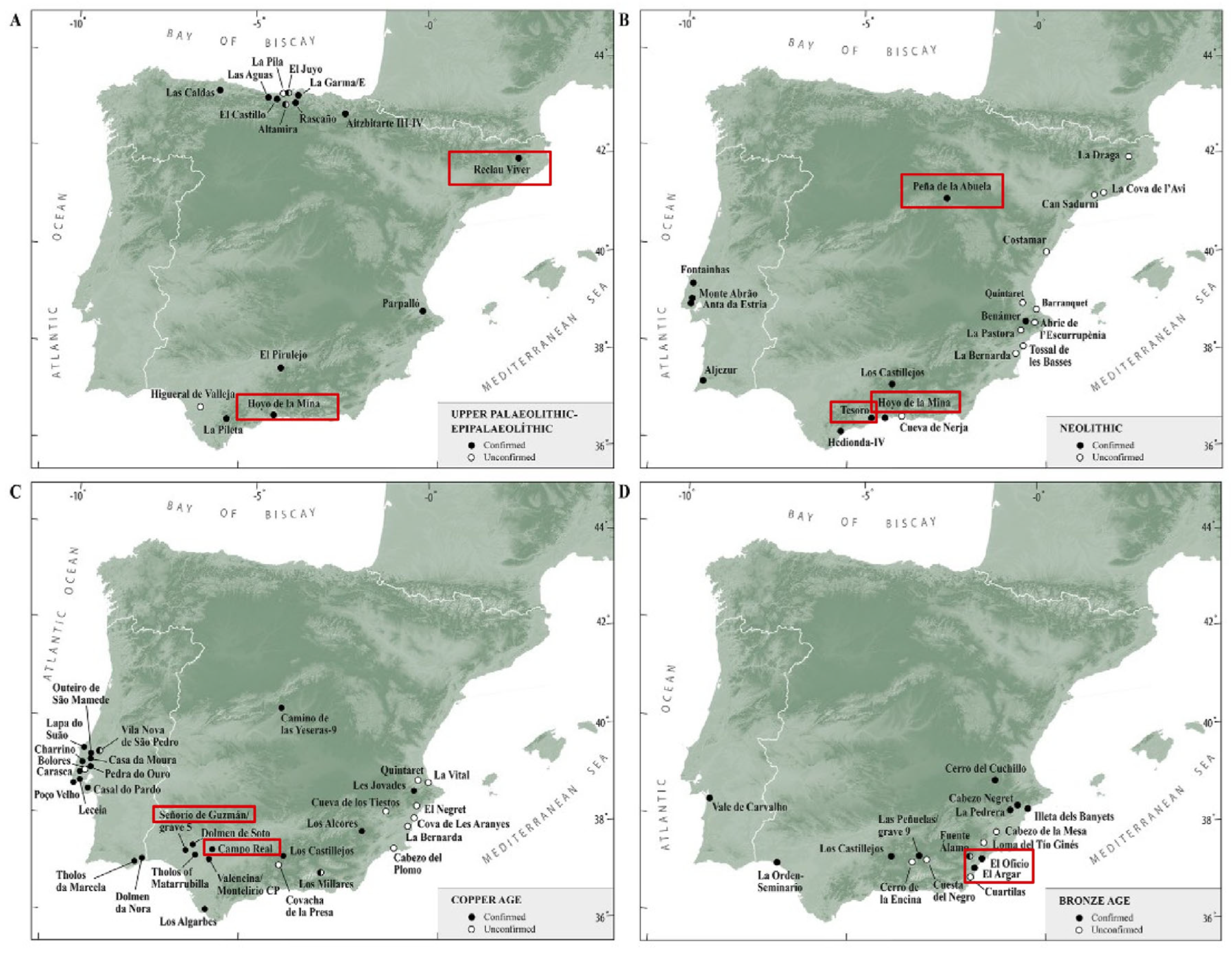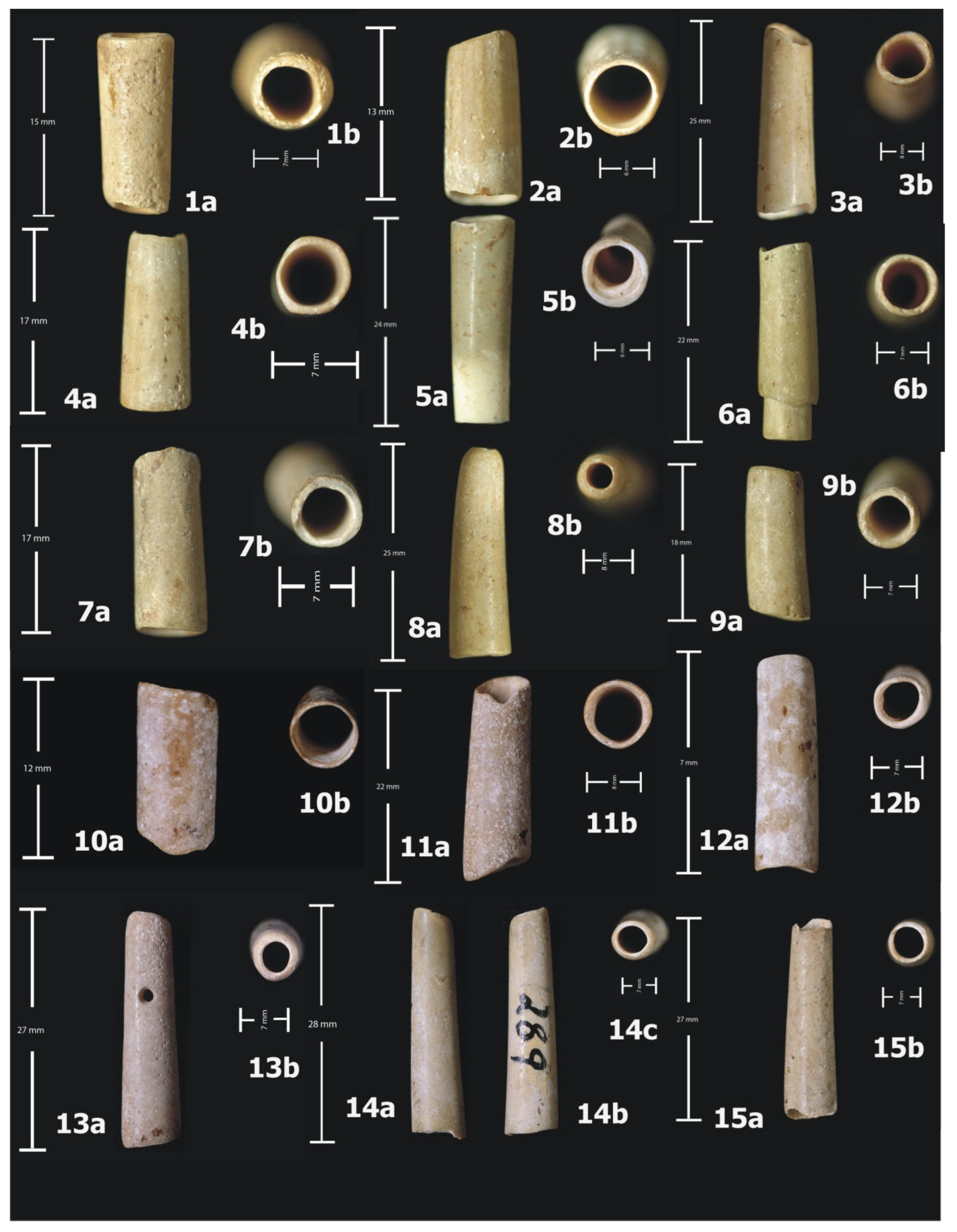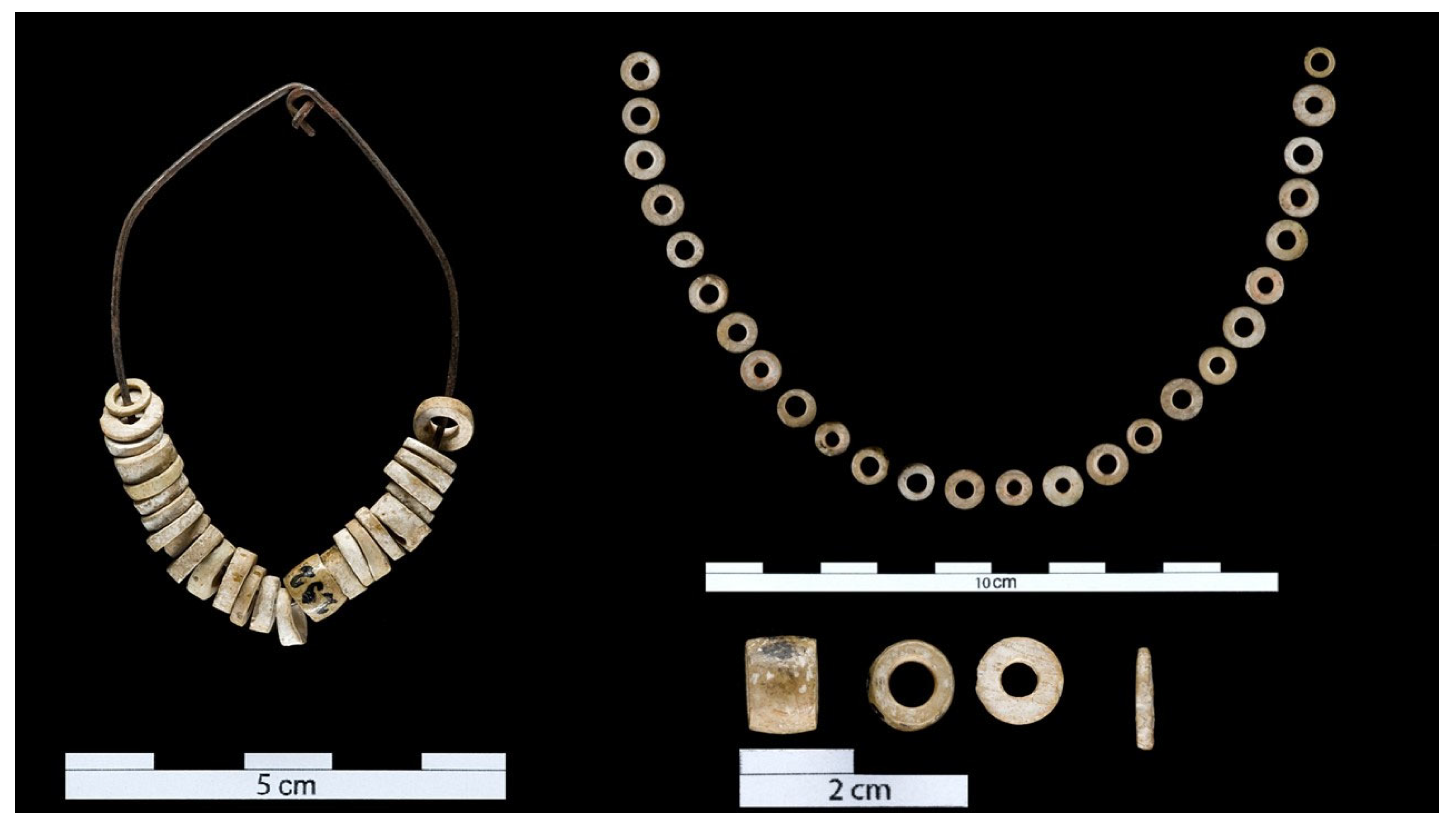Fossil Tusk Shells (Mollusca, Scaphopoda) in Archaeological Sites in the South of the Iberian Peninsula (Spain)
Abstract
1. Introduction
2. Material and Method
- (a)
- The external ornamentation: number and arrangement of primary and secondary axial costules.
- (b)
- Biometry, section of the shell wall, diameter of the oral and aboral openings, fragment length, expansion rate and curvature. The biometric analysis of each specimen has been carried out by taking measurements of the diameters of the oral and aboral openings, shell length and sections of the shell wall thickness (Vera-Peláez et al., 1993) [10].
- (c)
- For fossil assignment and chronostratigraphic dating, it has been compared with fossil species of scaphopods. In our case, Paradentalium sexangulum (Gmelin, 1791) and Paradentalium inaequale (Bronn, 1831) fossils from the Upper Zanclean (Lower Pliocene) of the four subsectors of the marine basins of Málaga (from west to east Málaga-Torremolinos, Vélez-Málaga, Mijas and Estepona) and Castell’Arquatto (Piemonte-Liguria basin, Italy) (Vera-Peláez et al., 1993; Vera-Peláez and Lozano-Francisco, 2004; Aguirre et al., 2005) [10,11,17].
3. Results
3.1. Cave of Tesoro (Torremolinos, Málaga)
- (a)
- 17 fragments of scaphopods attributable to Pliocene fossil species (Figure 2), (number DE00492), of which 15 fragments correspond to the species Paradentalium sexangulum Gmelin, 1790 and two fragments to Paradentalium inaequale Bronn, 1831.
- (b)
- ‘Disc’ type ornaments: 26 items, of which 9 were manufactured from P. sexangulum specimens (record number 00474), identified by their hexagonal section, shell wall thickness and shell diameter; six were obtained from P. inaequale specimens, clearly showing the characteristic sculpture of this species (Figure 3).
3.2. Cueva Del Hoyo De La Mina (Málaga)
- (a)
- 10 fragments of Paradentalium sexangulum shells, all of them missing the apex and the base; therefore, they correspond to medium-apical shell fragments. These specimens have been identified in Neolithic levels (levels HM3, HM4), Epipalaeolithic (level HM5) and in the final Upper Palaeolithic (levels HM6) (Figure 4).
- (b)
- An apical fragment of the shell of Paradentalium inaequale, missing the apex and the base; therefore, it is a medium-apical fragment. It has been identified in Epipalaeolithic levels (level HM5). The length of the fragment is 24.30 mm, and the maximum diameter is 5.45 mm.
4. Discussion
5. Conclusions
Author Contributions
Funding
Data Availability Statement
Acknowledgments
Conflicts of Interest
References
- Cortés-Sánchez, M.; Simón-Vallejo, M.D.; Carmelo Corral, J.; Lozano-Francisco, M.C.; Vera-Peláez, J.L.; Jiménez-Espejo, F.J.; García-Alix, A.; de las Heras, C.; Martínez Sánchez, R.; Bretones García, M.D.; et al. Fossils in Iberian prehistory: A review of the palaeozoological evidence. Quat. Sci. Rev. 2020, 250, 106676. [Google Scholar] [CrossRef]
- Navazo Ruiz, M.; Benito-Calvo, A.; Lozano-Francisco, M.C.; Alonso Alcalde, R.; Alonso García, P.; de la Fuente Juez, H.; Santamaría Diez, M.; Cristóbal Cubillo, P. Were neanderthals the first collectors? First evidence recovered in level 4 of the Prado Vargas cave, Cornejo, Burgos and Spain. Quaternary 2024, 7, 49. [Google Scholar] [CrossRef]
- Taborin, Y. La parure en coquillage au Paléolithique. In XXIXe Supplémenta Gallia Préhistoire; CNRS: Paris, France, 1993. [Google Scholar]
- Eriksen, B.V. (Ed.) Lithic raw material economy in late glacial and early postglacial western Europe. In British Archaeological Reports; Archaeopress: Oxford, UK, 2002; Volume 1093, p. 27e52. [Google Scholar]
- Simetsberger, B. Die Fossilien Molluskenreste aus Jungpalaolithischen und Neolithischen Fundstellen in Niederosterreich und Burgenland, Osterreich; Univiversitat Wien: Vienna, Austria, 1993. [Google Scholar]
- Steininger, F.F. Fossile und rezente Molluskenreste aus den palaolitischstationen Ostosterreichs. Geologische Herkunft, Bearbeitung, Verwendung und Import. In Schamanenzauber und Eiszeitkunst. Das Leben in der Altsteinzeit an Thaya, Pulkau und Donau. Katalog zur Sonderausstellun; Steininger, F.F., Reinhart, H., Eds.; Katalogreihe des Krahuletz Museums: Eggenburg, Austria, 1995; Volume 14, pp. 25–32. [Google Scholar]
- Álvarez-Fernández, E. Magdalenian personal ornaments on the move: A review of the current evidence in central Europe. Zephyrus 2009, 63, 45–59. [Google Scholar]
- Vanhaeren, M.; d’Errico, F.; Billy, E.; Grousset, F. Tracing the source of upper palaeolithic shell beads by strontium isotope dating. J. Archaeol. Sci. 2004, 31, 1481–1488. [Google Scholar] [CrossRef]
- Dimitrijević, V. The provenance and use of fossil scaphopod shells at the late Neolithic/Eneolithic site Vinča–Belo Brdo, Serbia. In Archaeomalacology: Shells in the Archaeological Record; Szabó, K., Dupont, C., Dimitrijević, V., Gastélum, L.G., Serrand, N., Eds.; BAR International Series: Oxford, UK, 2014; Volume 2666, pp. 33–42. [Google Scholar]
- Vera-Peláez, J.L.; Lozano-Francisco, M.C.; Guerra Merchán, A. Escafópodos (Mollusca, Scaphopoda) del Plioceno de la provincia de Málaga, España. Treb. Mus. Geol. Barc. 1993, 3, 117–156. [Google Scholar]
- Vera-Peláez, J.L.; Lozano-Francisco, M.C. La colección de escafópodos pliocénicos (Mollusca, Scaphopoda) del Museo Municipal Paleontológico de Estepona (Málaga, España) con la descripción de tres nuevas especies. Pliocenica 2004, 4, 51–94. [Google Scholar]
- Ferre, E.; Cortés-Sánchez, M.; Ramos, J.; Senciales, J.M.; Lozano-Francisco, M.C.; Vera-Peláez, J.L.; Aguilera, R.; Navarrete, I. El Cuaternario reciente en el sector oriental de la Bahía de Málaga. Rasas y depósitos marinos, continentales y arqueológicos. Cuaternario Geomorfol. 2004, 18, 73–93. [Google Scholar]
- Navarro, E.J. Estudio Prehistórico Sobre la Cueva del Tesoro; Biblioteca Andaluza: Málaga, Spain, 1884. [Google Scholar]
- Simón-Vallejo, M.D.; Macías Tejada, S.; Cortés-Sánchez, M. La “edad oscura” de la investigación del Neolítico en la bahía de Málaga (1884–1963). Mainake 2021, 39, 23–46. [Google Scholar]
- Baldomero, A.; Ferrer, J.E.; Marqués, I.; Ramos, J.; Aguilera, R.; Bañares, M.; Cortés-Sánchez, M.; Navarrete, I. Recientes excavaciones en Hoyo de la Mina Málaga. In Proceedings of the III Congreso del Neolítico en la Península Ibérica, Santander, Spain, 5–8 October 2003; pp. 999–1010, ISBN 84-8102-975-0. [Google Scholar]
- Such, M. Avance al Estudio de la Caverna Hoyo de la Mina; Universaidad de Málaga: Málaga, Spain, 1920; ISBN 9788474965971. [Google Scholar]
- Aguirre, J.; Cachão, M.; Domenech, R.; Lozano-Francisco, M.C.; Martinell, J.; Mayoral, E.; Santos, A.; Vera-Peláez, J.L.; Da Silva, C.M. Integrated biochronology of the Pliocene deposits of the Estepona basin (Málaga, S Spain). Palaeobiogeographic and palaeoceanographic implications. Rev. Española Paleontol. 2005, 20, 225–244. [Google Scholar] [CrossRef]
- Bromley, R.G. Concepts in ichnotaxonomy illustrated by small round holes in shells. Acta Geol. Hisp. 1981, 16, 55–64. [Google Scholar]
- Pascual Benito, J.L. Utillaje Óseo, Adornos e Ídolos Neolíticos Valencianos; Servicio de Investigación Prehistórica: Valencia, Spain, 1998. [Google Scholar]
- Taborin, Y. Langage Sans Parole: La Parure Aux Temps Préhistoriques; Maison des Roches: Paris, France, 2004. [Google Scholar]
- Steiner, G. Scaphopoda from the Spanish coasts. Iberus 1997, 15, 95–111. [Google Scholar]
- Orueta, D. Los Barros de los Tejares; Imprenta Económica: Málaga, Spain, 1874; p. 35. [Google Scholar]
- Malatesta, A. Malacofauna pliocenica Umbra. In Memorie Carta Geologica d’Italia; Ugo Pinto: Rome, Italy, 1974; Volume 13, p. 498. [Google Scholar]
- Aguirre, J. Tafonomía y evolución sedimentaria del Plioceno marino en el litoral sur de España entre Cádiz y Almería. Ph.D. Thesis, Universidad de Granada, Granada, Spain, 1995. [Google Scholar]
- Aguirre, J. Evolución paleoambiental y análisis secuencial de los depósitos pliocenos de Almayate (Málaga, sur de Málaga). Rev. Soc. Geol. España 2000, 13, 431e443. [Google Scholar]
- Álvarez-Fernández, E.; Harzhauser, M.; Vera, J.L. Estudio de los escafópodos (Mollusca, Scaphopoda) de la “Tumba Calero” de la Peña de la Abuela (Soria). In Un desafío a la Eternidad: Tumbas Monumentales del Valle de Ambrona. Arqueología en Castilla y León; Rojo, M.A., Kunst, M., Peña, R.G., de Lagrán, Í.G.M., Dauchez, G.M., Eds.; Junta de Castilla y León, Consejería de Cultura y Turismo: Valladolid, Spain, 2003; Volume 14, pp. 311–316. [Google Scholar]
- Avezuela, B.; Fernandez, E.Á. Los objetos de adorno-colgantes durante el Solutrense en la península ibérica. Espac. Tiempo Forma. Ser. I Nueva Época. Prehist. Arqueol. 2012, 5, 323e332. [Google Scholar] [CrossRef]
- Schuhmacher, T.X.; Banerjee, A.; Dindorf, W.; Nocete, F.; Vargas, J.M. Los marfiles del yacimiento de Valencina de la Concepción en el contexto del Calcolítico del suroeste peninsular. In El Asentamiento Prehistórico de Valencina de la Concepción. Actas del Congreso Conmemorativo del Descubrimiento de La Pastora (1860–2010); García, L., Jiménez, J.M., Eds.; Universidad de Sevilla: Sevilla, Spain, 2013; pp. 445–460. [Google Scholar]




| AS | Species | SU | MMI | Cultural Stage | ky BP | FRA | FO |
|---|---|---|---|---|---|---|---|
| Reclau Viver | Paradentalium sexangulum | necklace beads | 49 | Solutrean | 20-19 | Tortonian–Piacenzian | Alt Penedès basin (Girona) (Pliocene) |
| Hoyo de la Mina | Paradentalium inaequale | necklace beads | 1 | Upper Magdalenian | 13.5-11 | Tortonian–Piacenzian | Málaga basin (Pliocene) |
| Hoyo de la Mina | Paradentalium sexangulum | necklace beads | 6 | Epipalaeolithic | 11-8 | Tortonian–Piacenzian | Málaga basin (Pliocene) |
| Hoyo de la Mina | Paradentalium sexangulum | necklace beads | 2 | Epipalaeolithic-Neolithic | Tortonian–Piacenzian | Málaga basin (Pliocene) | |
| Hoyo de la Mina | Paradentalium sexangulum | necklace beads | 4 | Neolithic | 7-6 | Tortonian–Piacenzian | Málaga basin (Pliocene) |
| Hoyo de la Mina | Antalis inaequicostatum | necklace beads | 2 | Neolithic | 7-6 | Late Pliocene | Málaga basin, (Pliocene) |
| Peña de la Abuela/Grave | Paradentalium sexangulum | necklace beads | 154 * | Neolithic | 7-6 | Tortonian–Piacenzian | Baix Ebre (Pliocene) |
| Tesoro | Paradentalium sexangulum Paradentalium inaequale | necklace beads | 15 11 | Neolithic | 6-5 | Tortonian–Piacenzian | Torremolinos basin (Pliocene) |
| Campo Real (Open-air) | Paradentalium sexangulum | necklace beads | 2 | Cooper Age | 4.2-3.9 | Tortonian–Piacenzian | Guadalquivir basin (Sevilla) (Pliocene) |
| Senorío de Guzmán (Tholos) | Paradentalium inaequale | necklace beads | 1 | Cooper Age | 4.2-3.9 | Tortonian–Piacenzian | Guadalquivir basin (Huelva) (Pliocene) |
| El Oficio/Grave Open air | Paradentalium inaequale Paradentalium sexangulum | bracelet bracelet | 2 1 | Bronze Age | 3.8-3.3 | Tortonian–Piacenzian | Murcia (Plioceno) |
| El Argar (settlement) | Antalis vulgaris | necklace beads | 8 | Bronze Age | 3.8-3.3 | Late Pliocene | Cabo de Gata-Níjar basin (Pliocene) |
| TOTAL | 4 species | 258 |
| Chronocultural Segments Stratigraphic Levels | Chronocultural Segments. Stratigraphic Levels |
|---|---|
| Neolithic | HM3–4 |
| Epipalaeolithic | HM5 |
| Magdalenian | HM6 |
| Solutrean | HM7 |
| N. inv. | Length | Øoral | Øaboral | Wall Section | Observations |
|---|---|---|---|---|---|
| Apex/Base | Identification | ||||
| DE00492-1 | 15.34 | 6.57 | 5.84 | 1.45/1.11 | Hexagonal section |
| DE00492-2 * | 13.48 | 6.2 | 5.65 | - | Hexagonal section |
| P. sexangulum | |||||
| 14 axial ribs | |||||
| DE00492-3 | 24.4 | 7.42 | 6.3 | 1.04/0.91 | Hexagonal section |
| DE00492-4 | 17.66 | 7.62 | 6.33 | - | Hexagonal section |
| DE00492-5 | 24.31 | 6.38 | 5.2 | - | Hexagonal section |
| DE00492-6 * | 18.77 | 7.19 | 6.3 | - | mayor shell (outside) |
| Hexagonal section | |||||
| DE00492-6 * | 14.62 | 5.89 | 5.14 | - | minor shell (inside) |
| Hexagonal section | |||||
| DE00492-7 | 17.71 | 7.1 | 6.34 | - | Hexagonal section |
| DE00492-8 | 25.54 | 7.55 | 5.2 | 1.90/1.60 | High expansion rate |
| Hexagonal section | |||||
| P. inaequale | |||||
| DE00492-9 | 19.43 | 7.73 | 7 | very thin | P. sexangulum |
| DE00492-10 | 12.54 | 6.05 | 5.91 | - | Expansion rate = 0 |
| P. sexangulum | |||||
| DE00492-11 | 22.52 | 7.48 | 6.21 | - | P. sexangulum |
| Hexagonal section | |||||
| DE00492-12 | 25.56 | 7.44 | 6.72 | - | P. sexangulum |
| Hexagonal section | |||||
| P. inaequale | |||||
| DE00492-13 | 27.55 | 7.15 | 5.6 | - | Bioerosion: Oichnus paraboloides |
| DE00492-14 (289) | 28 | 7.31 | 5.52 | 1.25/0.95 | Hexagonal section |
| DE00492-15 | 26.85 | 7.28 | 5.74 | - | Hexagonal/oval base section |
| MA/HM/2000 | ||||||
|---|---|---|---|---|---|---|
| SP | H | Ømax | Ømin | Level | N. inv. | Observation |
| P. inaequale | 24.3 | 5.45 | 4.2 | E-5 | polished | |
| P. sexangulum | 25.75 | 6.85 | 5.5 | Cont. 3–4 | (995-2)-5 | polished |
| P. sexangulum | 27.6 | 6.9 | 5.3 | E-4 | 142-5 | outer shell |
| P. sexangulum | 20.7 | 5 | 4.2 | E-4 | 142-5 | inner shell |
| P. sexangulum | 34.3 | 6.3 | 4.3 | E-3 | 24 | polished |
| P. sexangulum | 14.4 | 6.6 | 6.2 | E-5 | 490-5 | polished |
| P. sexangulum | 13.6 | 5.8 | 5.5 | surface | 1444-5 | no details, hexagonal section |
| P. sexangulum | 19.1 | 7.6 | 6.5 | Cont. 3–4 | (462-2)-5 | inner shell |
| P. sexangulum | 3.9 | 7.6 | - | E-6-6′ | 554-5 | no details |
| P. sexangulum | hexagonal section | |||||
| P. sexangulum | 4.6 | 6.35 | - | E-3 | 23-may | no details |
| P. sexangulum | hexagonal section | |||||
| P. sexangulum | 13.15 | 5.3 | - | E-5 | (1019-5)-5 | no details |
| P. sexangulum | circular section | |||||
| Antalis inaequicostatum * | 8 | 2.9 | 2.6 | E-6 | 685-5 | pearlescent, polished |
| A. inaequicostatum * | 13.2 | 3.3 | 2.6 | Cont. 4–5 | 144-5 | pearlescent, polished |
| A. inaequicostatum * | 16.7 | 2.9 | 2.4 | E-5 | 81-5 | pearly, fissure |
| apical anthropic | ||||||
| A. inaequicostatum * | 10.5 | 3.25 | 2.55 | E-5 | 237.5 | no wear and tear |
| Antalis rubescens * | 11.35 | 4.7 | 4.4 | E-5 | 1419 | polished, circular-oval section |
| A. rubescens * | 11 | 3 | 2.5 | E-5 | 176-5 | pearlescent |
| Antalis sp. * | 25.4 | 5 | 3.7 | E-5 | 463-5 | inner shell |
| circular section | ||||||
| Antalis sp. * | 18.3 | 5.85 | 5.55 | Cont. 5–6 | 415-5 | no details |
| burnt |
| Archaeological Site | SC (Pendant) | Cultural Stage | Cal ka BP |
|---|---|---|---|
| Reclau Viver (cave) (2, 3) | 49 | Middle Solutrean | 20-19 |
| Hoyo de la Mina (cave) (1, 2) | 1 | Upper Magdalenian | 13.5-11 |
| 6 | Epipalaeolithic | 11-8 | |
| 2 | Upper Palaeolithic-Neolithic | ||
| 6 | Neolithic | 7-6 | |
| Peña de la Abuela (Open-air site, Grave) (4) | 154 | Neolithic | 7-6 |
| Tesoro (burial cave) (1, 2) | 26 | Neolithic | 6-5 |
| Campo Real (Open-air settlement) (2) | 2 | Copper Age | 4.2-3.9 |
| Señorío de Guzmán/5 (Tholos) (2, 5) | 1 | Copper Age | 4.2-3.9 |
| El Argar (Open-air settlement) (2, 5) | 8 | Bronze Age | 3.8-3.3 |
| El Oficio (Grave 269. Open-air settlement) (2) | 3 | Bronze Age | 3.8-3.3 |
| Total fragments | 258 |
| Period | SC | %SC |
|---|---|---|
| Solutrean | 49 | 18.99 |
| Magdalenian | 1 | 0.39 |
| Epipalaeolithic | 6 | 2.33 |
| Neolithic | 186 | 72.09 |
| Copper Age | 3 | 1.16 |
| Bronze Age | 11 | 4.26 |
| Unspecified layer | 2 | 0.78 |
Disclaimer/Publisher’s Note: The statements, opinions and data contained in all publications are solely those of the individual author(s) and contributor(s) and not of MDPI and/or the editor(s). MDPI and/or the editor(s) disclaim responsibility for any injury to people or property resulting from any ideas, methods, instructions or products referred to in the content. |
© 2025 by the authors. Licensee MDPI, Basel, Switzerland. This article is an open access article distributed under the terms and conditions of the Creative Commons Attribution (CC BY) license (https://creativecommons.org/licenses/by/4.0/).
Share and Cite
Lozano-Francisco, M.C.; Simón-Vallejo, M.D.; Vera-Lozano, J.A.; Vera-Peláez, J.L.; Cortés-Sánchez, M. Fossil Tusk Shells (Mollusca, Scaphopoda) in Archaeological Sites in the South of the Iberian Peninsula (Spain). Quaternary 2025, 8, 50. https://doi.org/10.3390/quat8030050
Lozano-Francisco MC, Simón-Vallejo MD, Vera-Lozano JA, Vera-Peláez JL, Cortés-Sánchez M. Fossil Tusk Shells (Mollusca, Scaphopoda) in Archaeological Sites in the South of the Iberian Peninsula (Spain). Quaternary. 2025; 8(3):50. https://doi.org/10.3390/quat8030050
Chicago/Turabian StyleLozano-Francisco, M. Carmen, M. Dolores Simón-Vallejo, José A. Vera-Lozano, José L. Vera-Peláez, and Miguel Cortés-Sánchez. 2025. "Fossil Tusk Shells (Mollusca, Scaphopoda) in Archaeological Sites in the South of the Iberian Peninsula (Spain)" Quaternary 8, no. 3: 50. https://doi.org/10.3390/quat8030050
APA StyleLozano-Francisco, M. C., Simón-Vallejo, M. D., Vera-Lozano, J. A., Vera-Peláez, J. L., & Cortés-Sánchez, M. (2025). Fossil Tusk Shells (Mollusca, Scaphopoda) in Archaeological Sites in the South of the Iberian Peninsula (Spain). Quaternary, 8(3), 50. https://doi.org/10.3390/quat8030050





